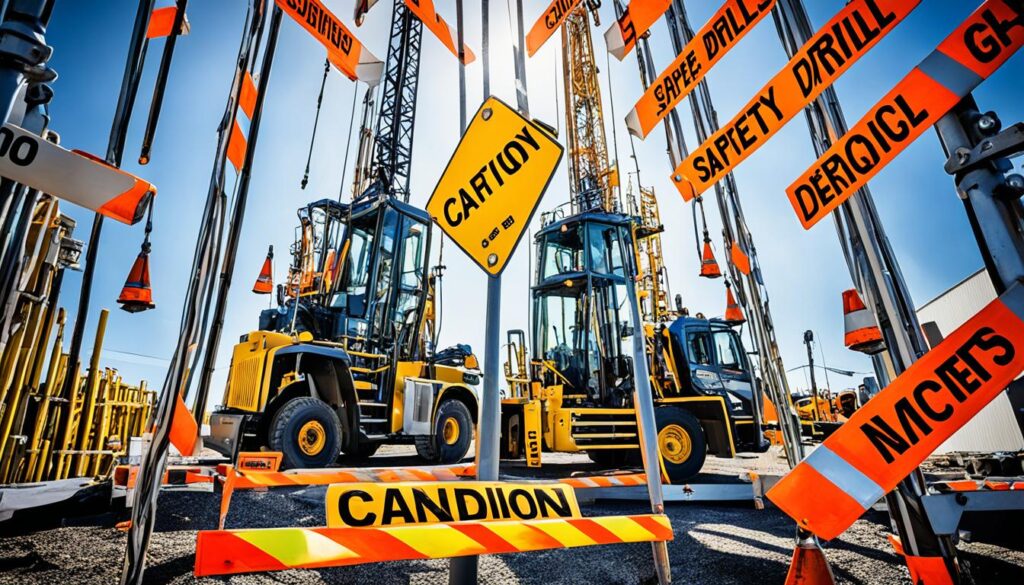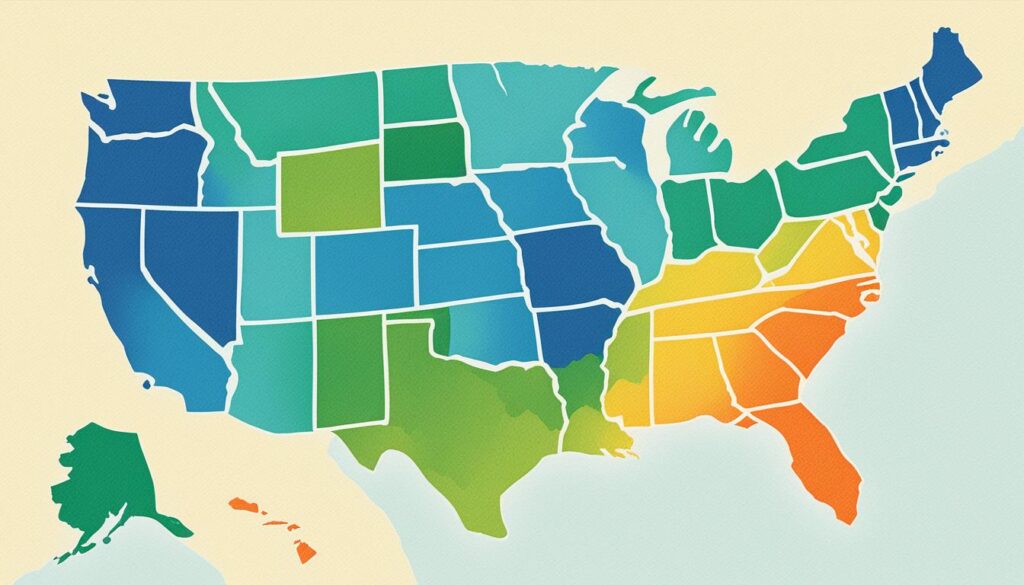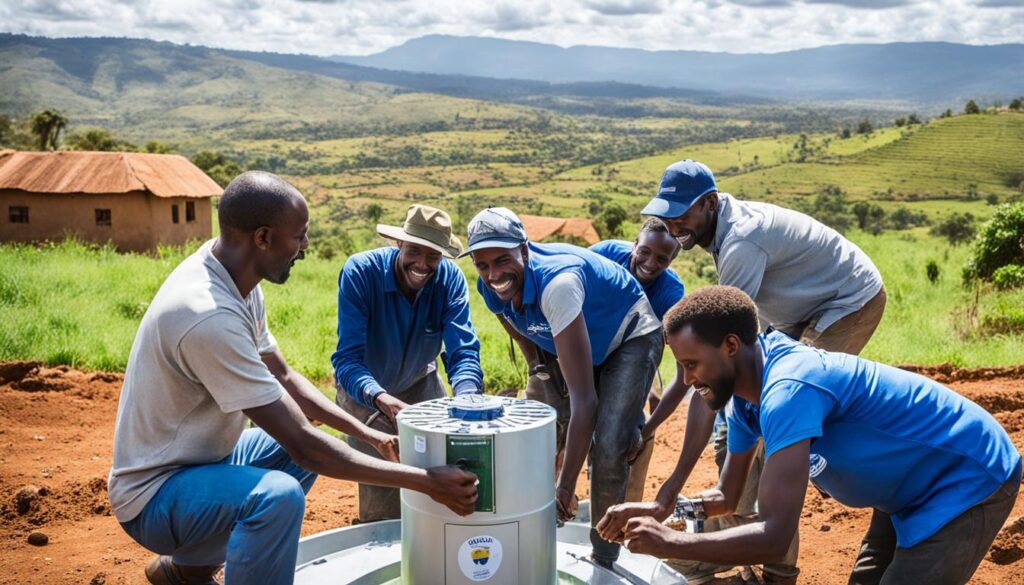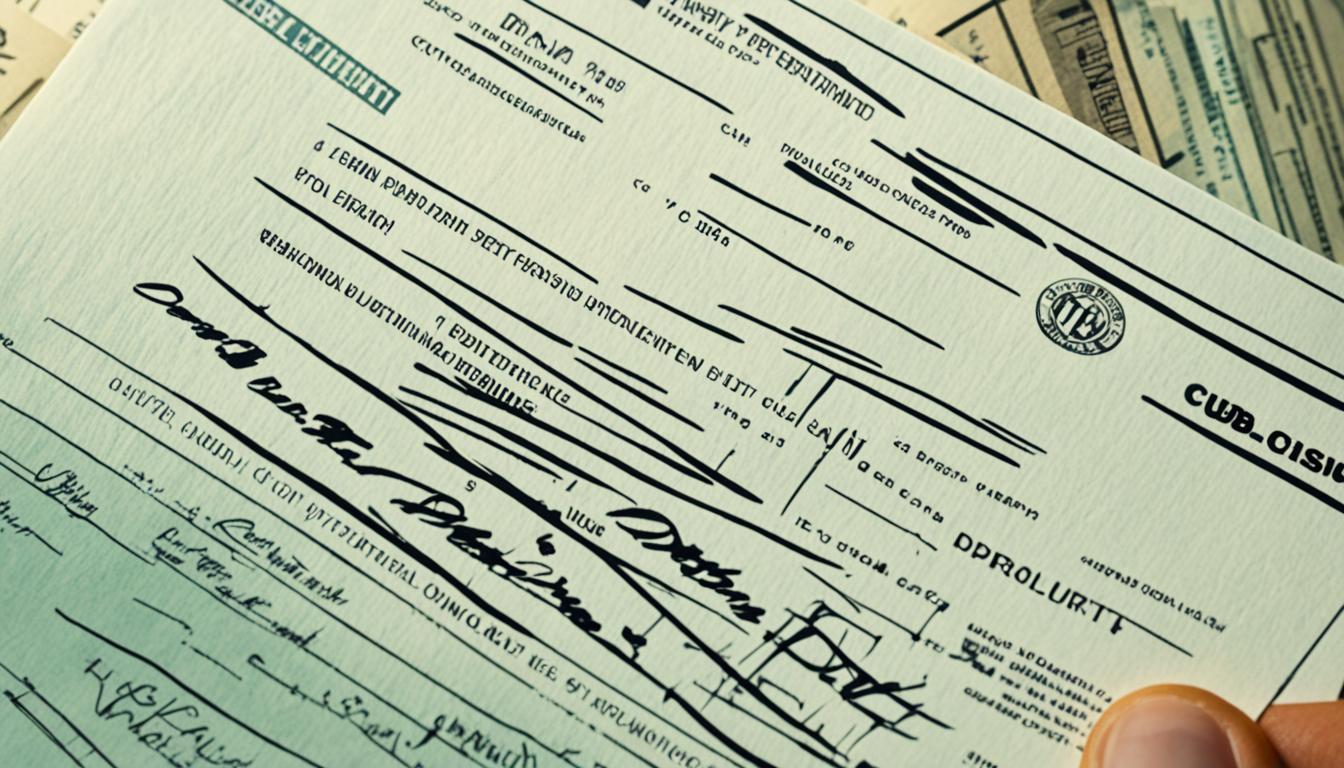This post contains affiliate links.
Did you know that obtaining well drilling permits in the United States involves complying with specific regulations and navigating a complex application process? Each year, thousands of individuals and businesses apply for permits to explore and extract groundwater resources through well drilling. Whether you are interested in water well drilling for personal use or for commercial purposes, understanding the permit application process and drilling regulations is crucial to ensure compliance and successful operation.
Key Takeaways:
- Obtaining well drilling permits in the United States requires compliance with specific regulations and a thorough understanding of the application process.
- Regulations, such as the Code of Federal Regulations and state-specific laws, outline the requirements for drilling permits and the environmental considerations to be addressed.
- The application process involves filing an application for permit to drill (APD) with the relevant regulatory agencies, such as the Bureau of Land Management (BLM) or state departments.
- Inspections, environmental assessments, and adherence to specific conditions of approval are essential steps in the permit approval process.
- Sustai
Federal Regulations for Well Drilling
The exploration, permitting, development, and production of onshore oil and gas deposits on Federal leases are governed by the Code of Federal Regulations (43 CFR 3160). These regulations are designed to promote the orderly and efficient exploration, development, and production of oil and gas resources.
Operators who wish to drill a well must file an application for permit to drill (APD) with the Bureau of Land Management (BLM). The BLM plays a vital role in the permit application process by conducting inspections and NEPA (National Environmental Policy Act) analyses to assess the potential impacts of the proposed drilling operation. These analyses consider factors such as historic preservation and compliance with the Endangered Species Act.
Once the application is reviewed, the BLM may either approve, deny, or defer action on the APD. If approved, the APD is valid for two years, with the possibility of a two-year extension.
Key Federal Regulations for Well Drilling
| Regulation | Description |
|---|---|
| Code of Federal Regulations (43 CFR 3160) | Governs exploration, permitting, development, and production of onshore oil and gas deposits on Federal leases |
| Bureau of Land Management (BLM) | Responsible for reviewing drilling permit applications and conducting inspections |
| National Environmental Policy Act (NEPA) | Requires environmental assessments to evaluate potential drilling impacts |
| National Historic Preservation Act | Regulates the preservation of historic sites during drilling operations |
| Endangered Species Act | Protects endangered species and their habitats from drilling activities |
Well Drilling Permits Process
The process of obtaining well drilling permits involves filing an application for permit to drill (APD) with the Bureau of Land Management (BLM) or relevant Surface Management Agencies (SMAs).
The BLM and SMAs conduct inspections, including onsite inspections, with surface and mineral estate owners, resource specialists, and the operator to ensure compliance with drilling regulations and environmental standards.
Before making a decision, the BLM and SMAs also conduct NEPA analyses to assess the potential environmental impacts of the drilling operation. These analyses consider factors such as air and water quality, wildlife habitat, and cultural resources.
Based on the inspection and NEPA analysis findings, the BLM and SMAs can approve, deny, or defer action on the permit application. Additionally, they may add Conditions of Approval to the APD to protect site-specific resources.
If the APD is approved, the operator receives the drilling permit, allowing them to commence drilling operations. The approved APD is generally valid for a period of two years; however, the validity can be extended for an additional two years if necessary.
To summarize:
- File an APD with the BLM or relevant SMAs
- Undergo inspections and NEPA analysis
- Receive approval, denial, or deferral of the permit application
- Observe any Conditions of Approval
- Commence drilling operations with the approved APD
Inspection Process
The inspection process conducted by the BLM and SMAs involves thorough evaluations of the proposed drilling site and its surroundings. These inspections aim to ensure compliance with drilling regulations and identify any potential risks to the environment or public safety.
The inspectors work closely with surface and mineral estate owners, resource specialists, and the operator to gather necessary information and address any concerns. Onsite inspections allow inspectors to assess the site conditions, evaluate mitigation measures, and verify compliance with regulatory requirements.
Through a collaborative approach, inspections contribute to the overall assessment of the permit application, helping the BLM and SMAs make informed decisions and protect the environment during the drilling process.
NEPA Analysis
The National Environmental Policy Act (NEPA) analysis is a crucial step in the drill permit application process. It evaluates the potential environmental, social, and economic impacts of proposed drilling operations.
The NEPA analysis examines various factors, including air and water quality, soil erosion, noise levels, wildlife habitat, cultural resources, and potential impacts on nearby communities. The analysis considers both the direct and indirect effects of the drilling activity.
By assessing the potential impacts, the NEPA analysis helps the BLM and SMAs determine whether the drilling operation aligns with environmental regulations and objectives. It contributes to the decision-making process, ensuring the responsible management of natural resources.
Guidelines for Safe Well Drilling
When it comes to well drilling, following safe procedures is of utmost importance to ensure the protection of the environment and the safety of operators. The Bureau of Land Management (BLM) provides operators with a comprehensive set of guidelines known as the Gold Book, which outlines the procedures for permitting and development on Federal oil and gas leases.
The Gold Book serves as a valuable resource, offering operators clear and detailed instructions on how to conduct well drilling operations in a safe and environmentally responsible manner. It covers various aspects of well drilling, including unitization, communitization, spacing, and drainage procedures.
By adhering to the guidelines outlined in the Gold Book, operators can minimize potential risks associated with drilling activities and ensure compliance with federal regulations. These guidelines act as a crucial resource to maintain the integrity of Federal oil and gas leases and protect the surrounding environment.

Production Measurement Team
In response to evolving industry practices and technological advancements, the BLM has established a Production Measurement Team. This team is responsible for evaluating and approving new measurement equipment, practices, and technologies. Their goal is to ensure accurate and reliable measurement of oil and gas production during the drilling process.
| Guidelines | Description |
|---|---|
| Unitization | Provides guidance on consolidating Federal oil and gas leases into a single unit to promote efficient production. |
| Communitization | Defines procedures for combining small tracts of Federal leases to facilitate coordinated development. |
| Spacing | Outlines requirements for the spacing of wells to avoid interference with neighboring operations. |
| Drainage | Addresses measures to prevent the undue drainage of hydrocarbons from neighboring properties. |
By adhering to these guidelines, operators can ensure the responsible development of Federal oil and gas leases, minimizing environmental impacts and maximizing production efficiency. It is crucial for operators to familiarize themselves with the Gold Book and stay up-to-date with any revisions or updates to these guidelines.
Safe well drilling practices play a vital role in protecting our natural resources and ensuring the long-term sustainability of the oil and gas industry. By following the guidelines provided by the BLM, operators can contribute to a safer and more environmentally conscious drilling process.
State Regulations for Well Drilling Permits
When it comes to well drilling permits, every state has its own set of regulations in place. The state of Pennsylvania, for instance, has specific guidelines outlined in the Pennsylvania Oil and Gas Act and the Pennsylvania Code (§ 78.11). It’s important to understand these regulations before proceeding with any drilling activities.
In Pennsylvania, drilling cannot take place without obtaining a permit. The permit itself contains important information such as the drilling depth and any limitations on water extraction. To apply for a drilling permit, you’ll need to submit a complete application along with an accurate plat, a permit application fee, and any necessary documents required by the Department of Environmental Protection (DEP).
It’s worth noting that in Pennsylvania, permit renewal is possible. However, it’s important to notify various stakeholders within a certain distance, including surface owners, coal owners, gas storage operators, and water supply owners.
Key Points:
- Each state has its own regulations for well drilling permits.
- Pennsylvania’s regulations can be found in the Pennsylvania Oil and Gas Act and the Pennsylvania Code (§ 78.11).
- Drilling permits specify the drilling depth and any limitations on water extraction.
- Applicants must submit a complete application, including an accurate plat, a permit application fee, and necessary documents required by the DEP.
- Permit renewal is possible, with notification required for various stakeholders within a certain distance.

Understanding state regulations for well drilling permits is crucial for complying with the law and ensuring the proper management of water resources. By following the permit requirements set forth by the Pennsylvania Oil and Gas Act and Pennsylvania Code, you can help protect the environment and promote sustainable drilling practices.
Requirements for Drilling Permit Applications in Pennsylvania
In Pennsylvania, if you’re looking to obtain a drilling permit, it’s important to understand the specific requirements outlined in the Pennsylvania Code (Chapter 79). These requirements ensure that drilling activities are conducted safely and in compliance with environmental regulations.
When submitting a drilling permit application, you’ll need to provide several key documents and meet specific criteria. Here’s what you’ll need:
- Survey of the Spacing Unit: You’ll be required to submit a survey that outlines the dimensions and boundaries of the spacing unit where the well is located. This helps ensure proper well placement and adherence to spacing regulations.
- Unit Operating Agreement: A signed unit operating agreement is necessary. This agreement should detail the roles, responsibilities, and financial arrangements between operators and royalty owners involved in the drilling operation.
- Affidavit or Stipulation: You may need to provide an affidavit or stipulation regarding the estimated cost of drilling the proposed well. This helps establish the financial commitment of the operator.
- Bonding: The Department of Environmental Protection (DEP) may require bonding to ensure compliance with section 215 of the act. Bonding provides financial assurance that any potential environmental damages or liabilities will be addressed.
- Notification and Fee: Applicants must provide notification to various stakeholders, such as surface owners, coal owners, gas storage operators, and water supply owners within a certain distance. Additionally, you’ll need to pay the applicable permit application fee.
It’s essential to meet these requirements to ensure a smooth drilling permit application process and compliance with Pennsylvania regulations. By adhering to these guidelines, you can contribute to the responsible and sustainable development of Pennsylvania’s natural resources.
For a comprehensive overview of the requirements, refer to Chapter 79 of the Pennsylvania Code and consult the Department of Environmental Protection (DEP) for further guidance.
Summary of Drilling Permit Application Requirements
| Requirement | Description |
|---|---|
| Survey of the Spacing Unit | Dimensions and boundaries of the spacing unit |
| Unit Operating Agreement | Signed agreement between operators and royalty owners |
| Affidavit or Stipulation | Estimated cost of drilling the proposed well |
| Bonding | Financial assurance for environmental damages |
| Notification and Fee | Notice to various stakeholders and payment of application fee |
Water Rights and Sustainability in Kenyan Borehole Drilling
Borehole drilling in Kenya requires obtaining water rights through permits issued by the Water Resources Authority (WRA). These permits specify the purpose, location, and volume of water that can be withdrawn. Sustainable water extraction is a key consideration, ensuring that the amount of water withdrawn does not exceed the aquifer’s natural recharge rate. Borehole owners are obligated to submit annual water use reports to the WRA, and violations of water regulations can result in penalties.

Sustainable Water Access
In the process of borehole drilling in Kenya, acquiring water rights is vital. The Water Resources Authority (WRA) issues permits that outline the specific purpose, location, and volume of water that can be extracted from the borehole. This important step helps regulate water access and usage to prevent overexploitation.
Protecting Aquifers and Sustainability
One of the main considerations in borehole drilling is to ensure that the rate of water extraction remains sustainable. The aquifer’s natural recharge rate defines the amount of water that can be safely withdrawn over time. By adhering to sustainable extraction practices, borehole owners can play a vital role in preserving the long-term availability of water resources.
Annual Reporting and Regulatory Compliance
To monitor and track water usage, borehole owners in Kenya are required to submit annual water use reports to the WRA. These reports provide crucial data on the amount of water extracted and help identify any potential issues related to water sustainability. Adhering to these reporting requirements ensures transparency and accountability in managing water resources.
Penalties for Violations
To enforce water regulations and prevent unauthorized water extraction, penalties may be imposed for violations. These penalties serve as a deterrent and help maintain compliance with sustainable water usage practices. Borehole owners must be aware of the regulations and guidelines set by the WRA to avoid any penalties or legal consequences.
Environmental Responsibility in Borehole Drilling
Borehole owners have a crucial role in preventing pollution and safeguarding both groundwater and surface water. It is not only a legal obligation but also a moral imperative to protect the environment. By adhering to regulations and following best practices, borehole owners can ensure the environmental integrity of water sources and actively contribute to pollution prevention, groundwater protection, and surface water protection.
Groundwater protection: Borehole owners must take measures to prevent contaminants from infiltrating the surrounding soil and entering the groundwater. This includes proper management and handling of hazardous substances, implementing effective containment systems, and regularly monitoring water quality to detect and address any issues promptly.
Surface water protection: Borehole drilling activities should also aim to preserve and protect surface water bodies such as rivers, lakes, and streams. This involves implementing erosion and sediment control measures, managing wastewater generated during drilling operations, and adhering to guidelines for responsible water usage.
Legal obligations: Borehole owners have a legal responsibility to comply with relevant environmental regulations and statutes that govern drilling activities. These regulations may include requirements for obtaining permits, reporting environmental impacts, and maintaining operational standards. By fulfilling these legal obligations, borehole owners contribute to a safer and healthier environment for all.
Adopting environmental responsibility practices in borehole drilling not only ensures compliance with the law but also promotes sustainability and the long-term availability of water resources. By safeguarding groundwater and surface water, borehole owners play a crucial role in preserving the environment for present and future generations.

Importance of Pollution Prevention Measures
Pollution prevention measures are vital in borehole drilling to minimize the potential adverse impacts on the environment and public health. Implementing effective pollution prevention strategies includes:
- Proper containment and disposal of drilling fluids and cuttings.
- Ensuring proper well construction and sealing to prevent contamination.
- Evaluating and managing the risks associated with chemical usage during drilling operations.
- Implementing spill prevention and response plans to mitigate accidental releases.
By prioritizing pollution prevention measures, borehole owners demonstrate their commitment to environmental responsibility and contribute to the preservation of precious water resources.
| Benefits of Environmental Responsibility in Borehole Drilling | Ways to Achieve Environmental Responsibility |
|---|---|
|
|
“Environmental responsibility in borehole drilling is not just a legal requirement; it is a commitment to the sustainable management of our water resources and the protection of our environment.” – John Smith, Environmental Specialist
Conclusion
Navigating the well drilling permit process is essential for individuals, businesses, and communities looking to harness groundwater resources while ensuring environmental responsibility. Well drilling permits are governed by both federal and state regulations, and understanding and complying with these regulations is crucial for a successful permit application process.
By following the specific requirements for permit applications and drilling procedures, you can obtain the necessary permits to explore and extract groundwater resources. These regulations not only safeguard the environment but also ensure the long-term sustainability of water resources.
Responsible water usage is paramount to protecting the availability of groundwater and maintaining environmental integrity. By adhering to legal considerations and regulations, we can collectively contribute to the sustainable management of water resources. Let us work together to secure a brighter future for the United States, one where we prioritize sustainability, protect water rights, and uphold our environmental responsibilities.
FAQ
What is the process for obtaining well drilling permits in the United States?
The process involves complying with specific drilling regulations and navigating the permit application process. Operators must file an application for permit to drill (APD) with the Bureau of Land Management (BLM) and meet the requirements of laws such as the National Environmental Policy Act, the National Historic Preservation Act, and the Endangered Species Act. The BLM conducts inspections and NEPA analyses before approving, denying, or deferring action on the application. Approved APDs are valid for two years, with a possible extension.
What are the federal regulations for well drilling?
The Code of Federal Regulations (43 CFR 3160) outlines the regulations for onshore oil and gas operations, including the exploration, permitting, development, and production of wells on Federal leases. To obtain a drilling permit, operators must file an application for permit to drill (APD) with the Bureau of Land Management (BLM), which conducts inspections and NEPA analyses before approving, denying, or deferring action on the application. The BLM also considers other regulations such as the National Historic Preservation Act and the Endangered Species Act. Approved APDs are valid for two years, with the possibility of a two-year extension.
How does the well drilling permits process work?
The process involves filing an application for permit to drill (APD) with the Bureau of Land Management (BLM) or relevant Surface Management Agencies (SMAs). The BLM and SMAs conduct inspections, including onsite inspections, with surface and mineral estate owners, resource specialists, and the operator. They also conduct NEPA analyses before approving, denying, or deferring action on the application. The BLM and other SMAs may add Conditions of Approval to the APD to protect site-specific resources. An approved APD is valid for two years, or until the lease expires, with a possible two-year extension.
Are there guidelines for safe well drilling procedures?
Yes, the Bureau of Land Management (BLM) provides operators with guidelines for safe and environmentally responsible well drilling procedures through the Gold Book. The Gold Book outlines procedures for permitting and development on Federal oil and gas leases. The BLM also provides guidance on unitization, communitization, spacing, and drainage procedures. In response to Onshore Orders, the BLM has formed a Production Measurement Team responsible for approving new measurement equipment, practices, and technologies.
What are the state regulations for well drilling permits?
Each state has its own regulations for well drilling permits. In Pennsylvania, for example, drilling permits are regulated by the Pennsylvania Oil and Gas Act and the Pennsylvania Code (§ 78.11). Drilling cannot occur without obtaining a permit, and the permit specifies the drilling depth and any limitations on water extraction. Applicants must submit a complete application with an accurate plat, a permit application fee, and necessary documents required by the Department of Environmental Protection (DEP). Permit renewal is possible, with notification required for surface owners, coal owners, gas storage operators, and water supply owners within a certain distance.
What are the requirements for drilling permit applications in Pennsylvania?
Drilling permit applications in Pennsylvania must meet specific requirements outlined in the Pennsylvania Code (Chapter 79). These requirements include submitting a survey of the spacing unit, a unit operating agreement signed by operators and royalty owners, and an affidavit or stipulation regarding the cost of the proposed well. The Department of Environmental Protection (DEP) may require bonding for compliance with section 215 of the act. Applicants must also provide notification and pay the applicable permit application fee. Permit renewal is possible, with notification required for various stakeholders within a certain distance.
What is the process for borehole drilling in Kenya?
Borehole drilling in Kenya requires obtaining water rights through permits issued by the Water Resources Authority (WRA). These permits specify the purpose, location, and volume of water that can be withdrawn. Sustainable water extraction is a key consideration, ensuring that the amount of water withdrawn does not exceed the aquifer’s natural recharge rate. Borehole owners are obligated to submit annual water use reports to the WRA, and violations of water regulations can result in penalties.
What responsibilities do borehole owners have in terms of environmental protection?
Borehole owners have a responsibility to prevent pollution and protect both groundwater and surface water. It is not only a legal obligation but also a moral imperative to safeguard the environment. Adhering to regulations and best practices ensures the environmental integrity of water sources and upholds the principles of responsible borehole drilling.
What is the importance of well drilling permits and environmental responsibility?
Navigating the well drilling permit process involves understanding and complying with regulations, obtaining permits, and practicing environmental responsibility. Well drilling permits are regulated by federal and state governments, with specific requirements for permit applications and drilling procedures. Sustainability and responsible water usage are vital considerations, ensuring the long-term availability of groundwater resources. By adhering to the legal considerations and regulations, individuals, businesses, and communities can contribute to the sustainable management of water resources and secure a brighter future for all.
Source Links
- https://www.swarthmore.edu/environmental-studies-capstone/drilling-permits
- https://www.blm.gov/programs/energy-and-minerals/oil-and-gas/operations-and-production
- https://www.linkedin.com/pulse/navigating-borehole-drilling-water-rights-deep-dive-kenyas-regulatory
This post contains affiliate links.

